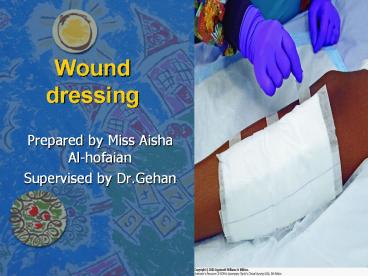Wound dressing - PowerPoint PPT Presentation
Title:
Wound dressing
Description:
Wound dressing Prepared by Miss Aisha Al-hofaian Supervised by Dr.Gehan Purpose 1- To promote wound ... Support and hold the drain erect while cleaning around ... – PowerPoint PPT presentation
Number of Views:174
Avg rating:3.0/5.0
Title: Wound dressing
1
Wound dressing
- Prepared by Miss Aisha Al-hofaian
- Supervised by Dr.Gehan
2
Purpose
- 1- To promote wound healing by primary intention
. - 2- To prevent infection .
- 3- To assess the healing process
- 4- To protect the wound from mechanical trauma .
- 5- To absorb drainage.
- 6- To prevent contamination from bodily discharge.
3
Types of dressings
- Dry - to dry
- Used primarily for wounds closing by primary
intention. - Layer of wide mesh cotton gauze lies next to the
wound surface , second layer of dry absorbent
cotton to protect the wound
4
Types of dressings
- Wet to dry
- These are particularly useful for untidy or
infected wounds that must be debrided and closed
by secondary intention - Layer of wide mesh cotton gauze saturated with
saline next to wound surface ,second layer of
moist absorbent with same solution to debride the
wound
5
Cont..
- Wet to damp
- Variation of wet to dry dressing .
- Wet to wet
- Used in clean open wounds.
- Layer of wide mesh gauze saturated with
antibacterial solution next to the wound surface,
second layer of absorbent material saturated with
the same solution to dilutes viscous exudates .
6
Assessment
- 1- Client allergies to wound cleaning agents.
- 2- The appearance and size of the wound .
- 3- The amount and character of exudates.
- 4- Client complaints of discomfort.
- 5- The time of last pain medication .
- 6- Signs of systemic infection ( e.g. .elevated
in body temp , diaphoresis, malaise ) .
7
Equipment
- -Moisture proof bag .
- -Mask .
- -Acetone solution to loosen adhesive .
- -Clean gloves.
- -Sterile gloves .
- -Sterile dressing set .
- -Additional supplies ( extra gauze dressing , and
ointment if ordered . - -Tie tapes, tape or binder .
- - Normal saline or antiseptic solution .
8
Implementation
- Before changing a dressing , determine any
specific order about dressing or wound. - Preparation
- - Acquire assistance for changing a dressing on
restless or confused client . - - Put the client to comfortable position in which
the wound can be readily exposed ( expose only
wound area ). - - Make cuff on the moisture proof bag for
disposal of the soiled dressings and place the
bag within reach . - - Put on face mask .
9
Performance
- 1- Explain procedure to the client .
- 2- wash hands.
- 3- provide for client privacy .
10
4- Remove binder and tape -remove binder if used
and place them aside . - If adhesive tape used ,
remove it by holding down the skin and pulling
the tape toward the wound . - Use solvent to
loose the tape if required .
11
5- Remove and dispose of soiled dressing . - Put
on clean gloves to remove outer dressing or
surgipad . - Place outer dressing away from
client . - Place the soiled dressing in moisture
proof bag without touch the outside the bag . -
Remove the under dressing , taking care not to
dislodge any drains , if the gauze sticks to the
drains , support the drain with one hand and
remove the gauze with other.
12
- Assess the location , type and odor of the wound
drainage and number of gauzes saturated . - Discard the soiled dressing in the bag as before
. - Remove clean gloves .
- - Wash hands or clean with antiseptic solution .
13
6- Setup sterile supplies . - Open the sterile
dressing set using aseptic technique . - Place
the sterile drape beside the wound . - Open the
sterile cleaning solution pour it over the gauze
sponges . - Put on sterile gloves .
14
7- Irrigate the wound -Instill a steady stream
of irrigating solution into the wound . -
Position the basin below the wound to receive the
irrigating -Use either a syringe with a catheter
attached or with irrigating tip to flush the
wound -Continue irrigating until the solution
becomes clear. -Dry the area around the wound.
15
- 8- Clean the wound .
- - Clean the wound using your gloved hands or
forceps and gauze swabs moisture with cleaning
solutions. - Use the cleaning method .
- Use a separate swab for each stroke and discard
each swab after use .
16
-If drain is present , clean the skin around the
drain site by swabbing it half or circle .
17
- Cont
- Support and hold the drain erect while cleaning
around . - Dry the surrounding skin with gauze swab as
required .do not dry wound or incision itself .
18
9- Apply dressing to the drain site and
incision. -Place a precut 4 in 4 gauze around
drain . -Apply the sterile dressing one at a
time over the drain and incision . -Apply
surgipad , remove gloves and dispose of them
. -Secure the dressing with tape or tie. - Wash
your hands. -Document the procedure and all
nursing assessment .

